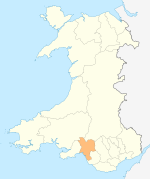Related Research Articles
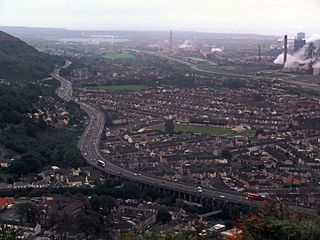
Port Talbot is a town and community in the county borough of Neath Port Talbot, Wales, situated on the east side of Swansea Bay, approximately eight miles from Swansea. The Port Talbot Steelworks covers a large area of land which dominates the south east of the town and is one of the biggest steelworks in the world but has been under threat of closure since the 1980s. The population was 37,276 in 2011.
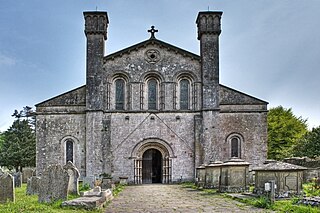
Margam Abbey was a Cistercian monastery, located in the village of Margam, a suburb of modern Port Talbot in Wales.

The M4, originally the London-South Wales Motorway, is a motorway in the United Kingdom running from west London to southwest Wales. The English section to the Severn Bridge was constructed between 1961 and 1971; the Welsh element was largely complete by 1980, though a non-motorway section around Briton Ferry bridge remained until 1993. On the opening of the Second Severn Crossing in 1996, the M4 was rerouted over it.

Neath Port Talbot is a county borough in the south-west of Wales. Its principal towns are Neath, Port Talbot, Briton Ferry and Pontardawe. The county borough borders Bridgend County Borough and Rhondda Cynon Taf to the east, Powys and Carmarthenshire to the north; and Swansea to the west.
Kenfig is a village and former borough in Bridgend, Wales. It is situated 1 mile (1.6 km) inland on the north bank of the Bristol Channel, and just south-west of the M4 motorway. To the east is the town of Bridgend, at approximately 6 miles (10 km), and the capital city of Cardiff, at 24 miles (40 km). To the west lies Port Talbot, at approximately 7 miles, and Swansea at approximately 18 miles.

Aberavon is a town and community in Neath Port Talbot county borough, Wales. The town derived its name from being near the mouth of the river Afan, which also gave its name to a medieval lordship. Today it is essentially a district of Port Talbot, covering the central and south western part of the town. Aberavon is also the name of the nearby Blue Flag beach and the parish covering the same area.
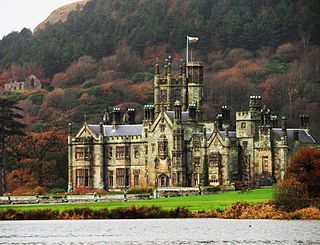
Margam Castle, Margam, Port Talbot, Wales, is a late Georgian country house built for Christopher Rice Mansel Talbot. Designed by Thomas Hopper, the castle was constructed in a Tudor Revival style over a five-year period, from 1830 to 1835. The site had been occupied for some 4,000 years. A Grade I listed building, the castle is now in the care of Neath Port Talbot County Borough Council.
Margam is a suburb and community of Port Talbot in the Welsh county borough of Neath Port Talbot, Wales, close to junction 39 of the M4 motorway. The community had a population of 3,017 in 2011; the built up area being larger and extending into Taibach community.

Margam Country Park is a country park estate in Wales, of around 850 acres (3.4 km²). It is situated in Margam, about 2 miles (3 km) from Port Talbot in south Wales. It was once owned by the Mansel Talbot family and is now owned and administered by the local council, Neath Port Talbot County Borough Council. Situated within the park are three notable buildings: Margam Abbey, a Cistercian monastery; Margam Castle, a neo-Gothic country house that was once the seat of the Mansel Talbot family; and the 18th-century Orangery.
Abercregan is a village in the community of Clymer and Glyncorrwg, in the Welsh county borough of Neath Port Talbot, Glamorgan. It is situated around 12 kilometres (7.5 mi) north-east of Port Talbot and just west of Cymmer, and is also close to the River Afan. Abercregan was once a thriving mining community but since the decline of the British coal industry, much of the housing has been demolished and most of its inhabitants have moved to neighbouring villages. The 1980s and 1990s saw the closure of the village school, the boys club, post office and the last remaining shop 1989. The local authority decided to turn the school into a Field Study Centre, which was later closed and relocated to Margam Park. The building was demolished following the closure.
Taibach or Tai-bach is a community and suburban district of Port Talbot, Wales. It is a settlement centered on the main A48 road, sandwiched between the river Ffrwdwyllt and Margam. Parts of Margam are within the community boundaries.

Bryn(English: Hill) is a village and community in Neath Port Talbot County Borough in Wales. It has a population of 913. The village is located in the hills between Cwmafan, in the Afan Valley, and Maesteg in the Llynfi Valley, approximately 6 miles (9.7 km) from Port Talbot and 2 miles (3.2 km) from Maesteg. The name of the village now familiarly 'Bryn', is Bryntroedygam. So wrote the first vicar of St Theodore's in Port Talbot. There was a farm situated above Meadow Row named Bryn-Troed-y-Garn as shown on the 1876 OS map, as many more immigrants came to 'Bryntroedygam' it seemed the name of the village was to be shorted to Bryn. 12% of the village speak Welsh. The population rose to 923 by 2011.

Port Talbot Steelworks is an integrated steel production plant in Port Talbot, West Glamorgan, Wales, capable of producing nearly 5 million tonnes of steel slab per annum. This makes it the larger of the two major steel plants in the UK and one of the largest in Europe. Over 4,000 people work at the plant. The majority of the slab is rolled on-site at Port Talbot and at the Newport Llanwern site to make a variety of steel strip products. The remainder is processed at other Tata Steel plants or sold in slab form. The works covers a large area of land which dominates the south of the town. Its two blast furnaces and steel production plant buildings are major landmarks visible from both the M4 motorway and the South Wales Main Line when passing through the town.
Sandfields is a mainly residential district of Port Talbot, Wales. The area is located in South Wales on a narrow coastal plain between Mynydd Dinas and the sea. The M4 motorway, A48 trunk road and South Wales Main Line run nearby. The area includes a council estate, industrial areas and a seaside resort at Aberavon Beach.

The A4119 links Tonypandy with Cardiff in South Wales.

The A4241 is a distributor road serving Port Talbot, Wales.

Edward Haycock Sr. was an architect working in the West Midlands and in central and southern Wales in the late Georgian and early Victorian periods.
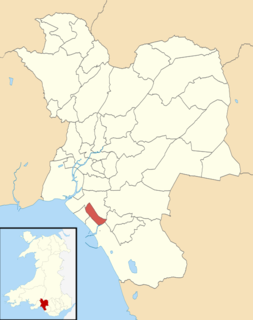
The electoral ward of Aberavon electoral ward includes the communities of Baglan and Baglan Bay, in Neath Port Talbot county borough, Wales. Baglan falls within the parliamentary constituency of Aberavon.

Beulah Calvinistic Methodist Chapel, also known locally as "The Round Chapel" and in Welsh as "Capel y Groes", is a Grade II*-listed building in Margam, Port Talbot, Wales. It originally built in the mid-nineteenth century and had to be dismantled and moved in 1974 to make way for the new M4 motorway.

Holy Cross Church, Port Talbot, also known locally as the "Chapel of Ease", is a Victorian church located centrally in the Taibach district of Port Talbot, Wales. Prior to the building of the M4 motorway flyover through the centre of the town in the 1960s, it was in the centre of a residential area, but it is now dominated by junction 40 of the motorway. The land was originally donated by C. R. M. Talbot, MP, the owner of the Margam Abbey estate, as a church for local people who could not get to the abbey itself to worship.
References
- 1 2 3 "Invisible Scars" (blog). Port Talbot Historical Society. 4 September 2013. Retrieved 5 December 2017.
- 1 2 3 4 Geraint Thomas (3 December 2017). "The 'Cotswolds-like' Welsh village reduced to rubble to make way for the M4". Wales Online . Retrieved 5 December 2017.
- ↑ "Topping out ceremony marks key milestone in the construction of Ysgol Cwm Brombil". Neath Port Talbot County Borough Council. 13 February 2018. Retrieved 9 May 2018.
Coordinates: 51°34′07″N3°44′47″W / 51.5686°N 3.7463°W
